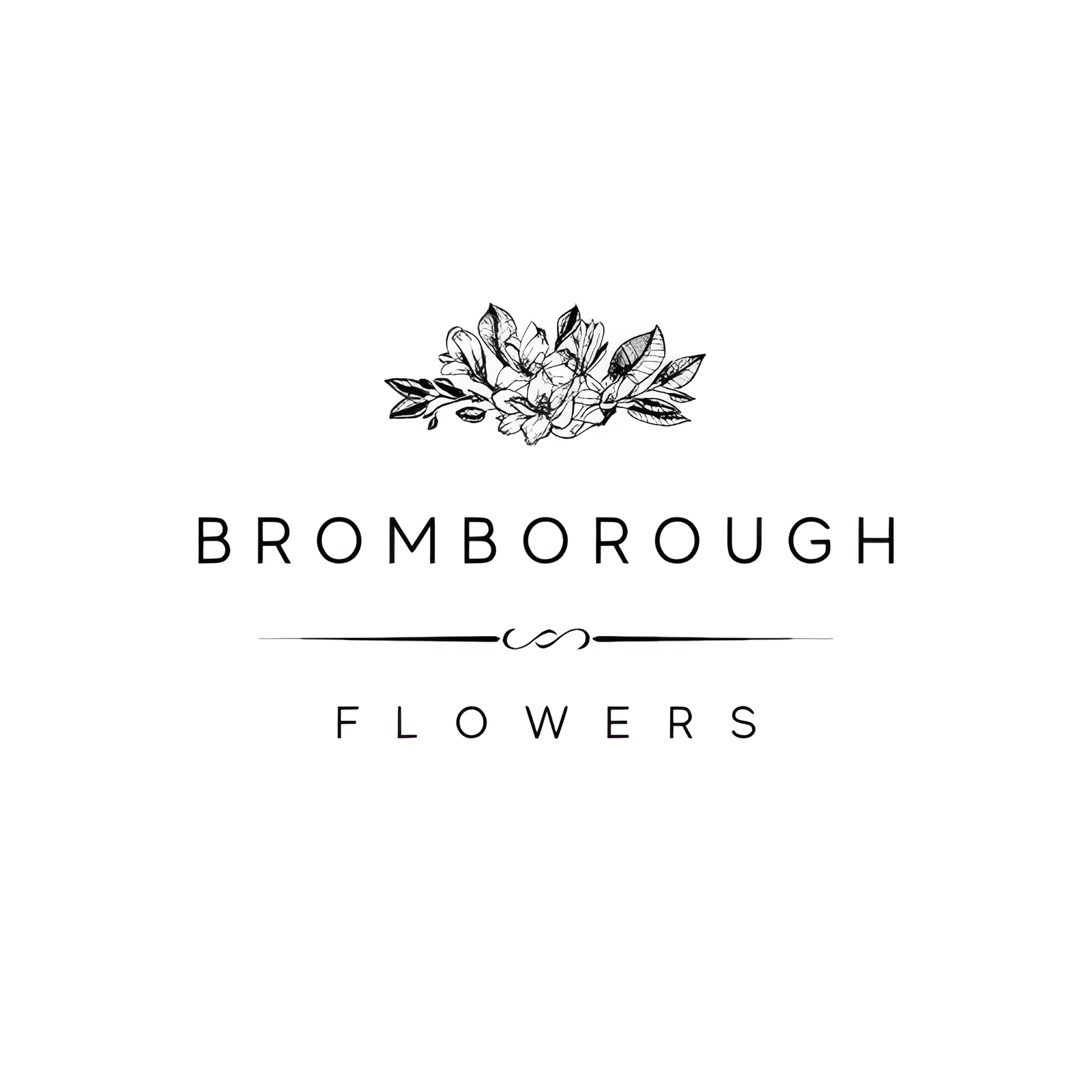When planning a wedding, selecting the right flowers is essential to creating a memorable ambiance, and asters, or Michaelmas daisies, present a versatile and sophisticated option. Known for their star-like appearance and multi-headed blooms, asters come in a diverse palette including hot pink, purple, red, white, and blue, offering year-round availability. These flowers not only enhance autumn weddings by symbolizing the changing season but also carry cultural significance as emblems of love and elegance. What makes asters particularly compelling for weddings, and how can they be incorporated into various floral arrangements?
Flower Overview
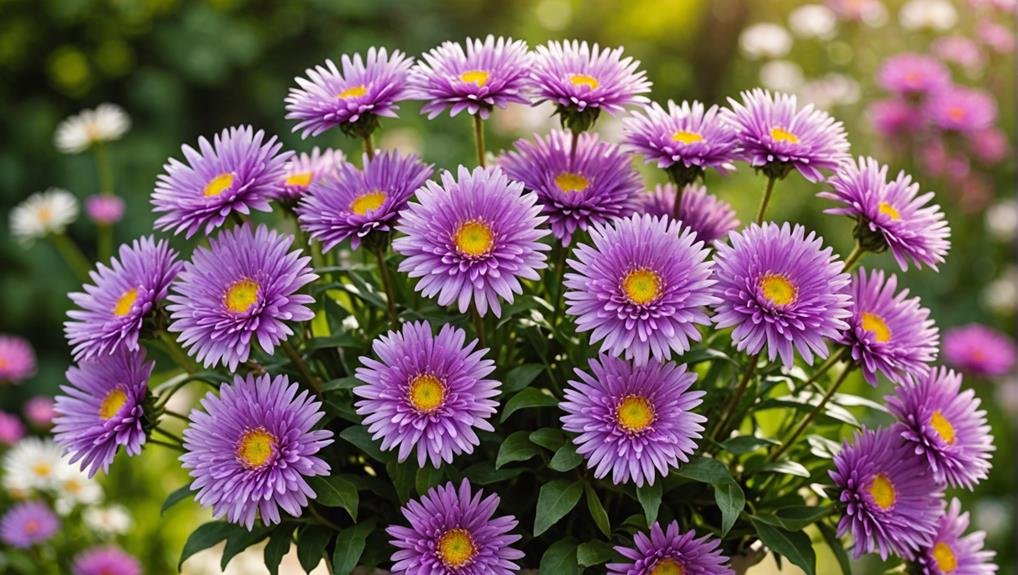
Originating from the Asteraceae family, asters, also known as Michaelmas daisies, are multi-headed flowers distinguished by their star-like appearance. The name 'aster' is derived from the Greek word for star, aptly reflecting the floral structure that resembles a celestial body.
These flowers are highly favored in the floristry trade due to their ability to add a touch of softness and charm to various floral arrangements.
Aster flowers are particularly popular in wedding arrangements, where they contribute to a cottage garden or vintage aesthetic. Their delicate appearance and versatile nature make them an ideal choice for bouquets, centerpieces, and other decorative elements in wedding ceremonies and receptions.
Florists frequently utilize asters to create an ethereal, romantic atmosphere that complements various wedding themes.
Wholesale asters are typically available in wraps of 25 stems, with stem lengths ranging from 60 to 90 centimeters. This availability guarantees that florists can access these flowers year-round, making them a dependable option for weddings in any season.
The consistent market presence of asters further highlights their significance and usefulness in both professional and personal floral arrangements, cementing their status as a staple in the floristry industry.
Physical Description
Asters exhibit a distinctive star-shaped structure with multiple florets radiating from a central disk, contributing to their ethereal and delicate appearance. Belonging to the Asteraceae family, these multi-headed flowers have an enchanting charm that makes them an excellent choice for wedding floral arrangements. Their intricate petals and central disk create a visual interest that enhances the aesthetic of any bouquet.
Asters are favored in the floristry trade for their versatility and ability to complement various floral designs. Their delicate appearance lends a touch of softness and romance, making them ideal for vintage and whimsical wedding themes. Available year-round in wholesale flower markets, Asters are typically sold in wraps containing 25 stems, with stem lengths ranging from 60 to 90 cm.
Key features of Asters include:
- Star-like appearance: Resembling a star, with florets radiating from a central disk.
- Multi-headed blooms: Each stem bears multiple flowers, adding volume to arrangements.
- Versatile design: Easily incorporated into different floral styles, from rustic to elegant.
- Year-round availability: Accessible throughout the year, ensuring a consistent supply for weddings.
- Range of stem lengths: Offering flexibility in bouquet design, suitable for various arrangements.
Incorporating Asters into wedding floral designs can create a charming and timeless look, perfect for any romantic celebration.
Available Colour Varieties
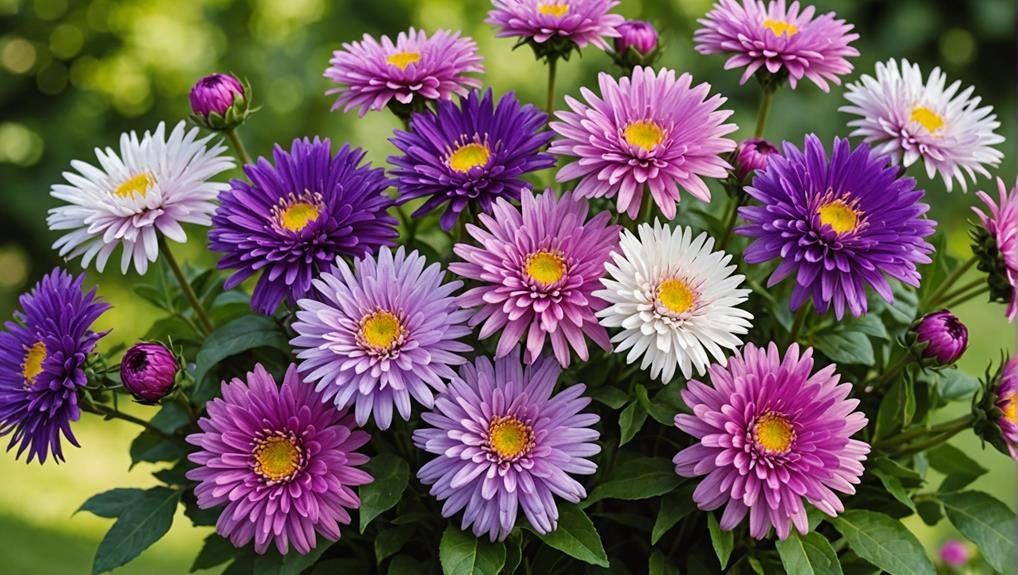
With a stunning array of colors such as hot pink, purple, red, white, and blue, these versatile flowers can seamlessly blend into various wedding themes and color schemes. The diverse palette provided by aster flowers makes them an excellent choice for wedding flowers, allowing for creative and personalized floral arrangements.
Asters in shades of purple and pink can add a touch of elegance and romance to bridal bouquets and centerpieces, while red asters offer a vibrant pop of color that can energize any wedding décor. White asters present a classic and timeless look, ideal for traditional weddings, and can be paired with other flowers to create sophisticated arrangements. Blue asters, although less common, bring a unique and serene quality to floral designs, making them an ideal choice for beach or coastal weddings.
The color versatility of asters not only enhances the beauty of the arrangements but also provides flexibility in matching the wedding's color scheme. Whether incorporated into bouquets, boutonnieres, or table centerpieces, the wide range of aster hues guarantees that your wedding flowers will be both striking and memorable.
Latin Name and Taxonomy
The diverse color palette of asters is complemented by their rich botanical background, known scientifically under the Latin name Aster and belonging to the Asteraceae family. This classification underscores the flower's significance in the world of botany and horticulture. The Latin name, Aster, aptly reflects the star-like appearance of these multi-headed blooms, which add a touch of softness to any bouquet.
The taxonomy of asters is equally fascinating, showcasing a variety of species that highlight their adaptability and versatility in floral arrangements. Some prominent species within this genus include:
- Symphyotrichum: Known for its late-blooming varieties, often extending the floral season into autumn.
- Eurybia: Characterized by its robust growth and ability to thrive in diverse environments.
- Doellingeria: Typically found in woodland areas, adding a unique texture to mixed bouquets.
- Aster amellus: A European species known for its vibrant colors and compact growth.
- Aster alpinus: A hardy species, ideal for rock gardens and colder climates.
Understanding the Latin name and taxonomy of Aster flowers not only enriches one's botanical knowledge but also aids in selecting the right variety for weddings and events, ensuring the perfect match for any theme or color scheme.
Geographical Origins
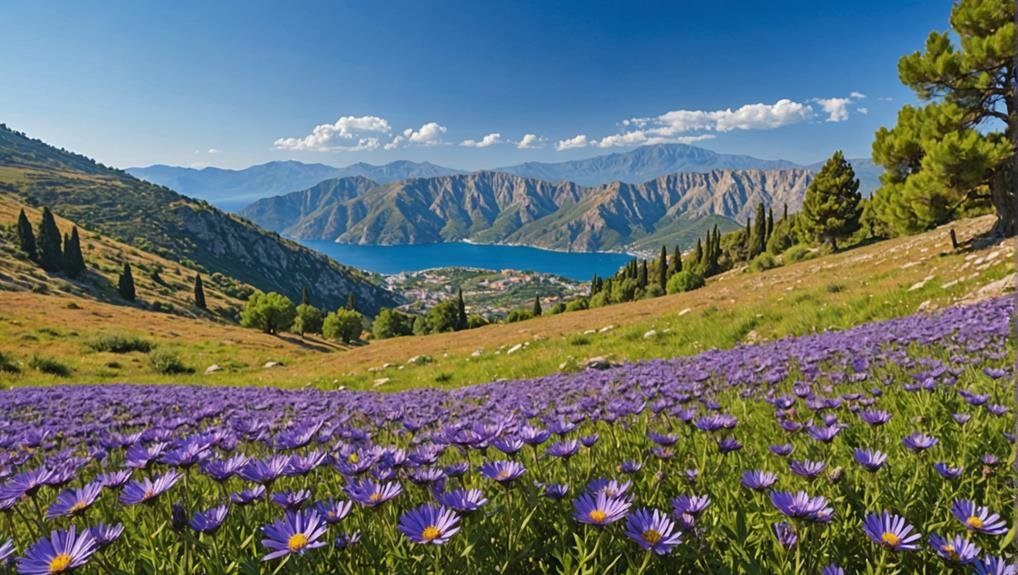
Originating from diverse regions across North America, Europe, and Asia, asters have a rich geographical history that highlights their adaptability and widespread appeal. These flowers thrive in temperate climates and are commonly found in meadows and grasslands, showcasing their natural resilience and ability to flourish in varied environments.
The geographical origins of asters are as varied as the species themselves. For instance, some species are native to the grasslands of North America, while others find their roots in the moors of Europe or the open fields of Asia. This diversity in origin has contributed significantly to their diverse availability in the floral industry, making them a popular choice for weddings and other events around the globe.
Cultivated for centuries, asters have been cherished not only for their beauty but also for their versatility. Their ability to adapt to different regions has made them a mainstay in gardens and floral arrangements worldwide.
The widespread geographical origins of asters ensure that they can be grown in a variety of settings, further enhancing their appeal as a go-to flower for various occasions. This adaptability underscores their enduring popularity and widespread use.
Season Availability
Asters reach their peak blossom between late July and September, making them perfect for adding a touch of early autumn allure to wedding celebrations. Their season availability aligns perfectly with the timing of September weddings, a month when many couples seek to capture the beauty of the shifting seasons.
Known for their vibrant hues and delicate petals, asters symbolize the end of the harvest period and the shift from summer to autumn. For couples planning September weddings, asters offer a versatile and meaningful floral option. As the birth month flower for September, they carry an extra layer of significance, making them a considerate choice for bouquets and arrangements.
These perennials bloom every summer, ensuring a dependable source of beauty for wedding florists.
Here are some key points about the season availability of asters:
- Peak Blossom: Late July to September
- Ideal for Early Autumn Weddings: Adds seasonal allure
- Symbolism: Represents the changing seasons and end of the harvest
- Birth Month Flower: Special significance for September weddings
- Dependable Perennials: Bloom annually, providing consistency
Asters' unique qualities and timely availability make them a favored choice for couples looking to celebrate their special day during the early autumn months.
Growing Conditions
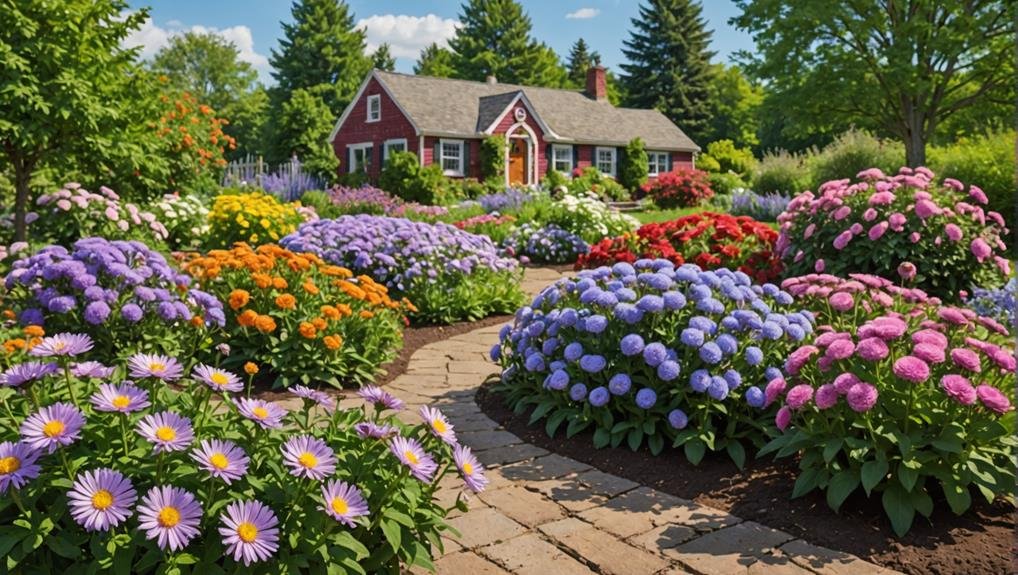
For best growth, aster plants require a combination of full sun to partial shade and well-drained soil conditions. Ensuring these elements are met is important for cultivating vibrant and healthy asters, which are ideal for both wholesale flowers and DIY wedding arrangements.
The necessity of well-drained soil cannot be overstated, as it prevents root rot and promotes robust growth.
Regular watering is essential to keep aster flowers thriving, particularly during dry spells. Consistent moisture levels help the plants maintain their lush appearance, which is critical when preparing wedding bouquets or centerpieces.
Pruning is another significant practice; it not only helps maintain the desired shape of the plants but also encourages new growth and a fuller bloom display.
Mulching around aster plants serves multiple purposes: it retains soil moisture, suppresses weeds, and adds an extra layer of protection. This is particularly beneficial for those engaging in DIY wedding preparations, ensuring the flowers remain in top condition until the big day.
Cultural Significance
The cultural significance of asters is deeply rooted in mythology, folklore, and symbolic meanings that span various traditions and events. In Greek mythology, asters are associated with the goddess Astraea, symbolizing patience and elegance. According to legend, when Astraea ascended to the heavens, her tears transformed into the starlike asters we see today. This myth imbues the flower with a sense of celestial beauty and endurance.
In Cherokee legend, asters are linked to the heartwarming story of two lovers who were reunited by the stars, making the flower a representation of love and daintiness. Additionally, asters hold a special place for those born in September, as they are the birth month flower for this month, adding a personal and unique touch to any celebration.
Asters are often incorporated in bridal showers and weddings, embodying themes of love, elegance, and enchantment. Their diverse range of colors, including hot pink, purple, red, and white, allows for customizable arrangements suitable for various occasions.
- Greek mythology: Associated with the goddess Astraea
- Cherokee legend: Symbol of love and reunion
- September birth flower: Personal significance for September-born individuals
- Versatile colors: Hot pink, purple, red, and white
- Bridal showers: Symbolize love and elegance
Typical Use in Weddings
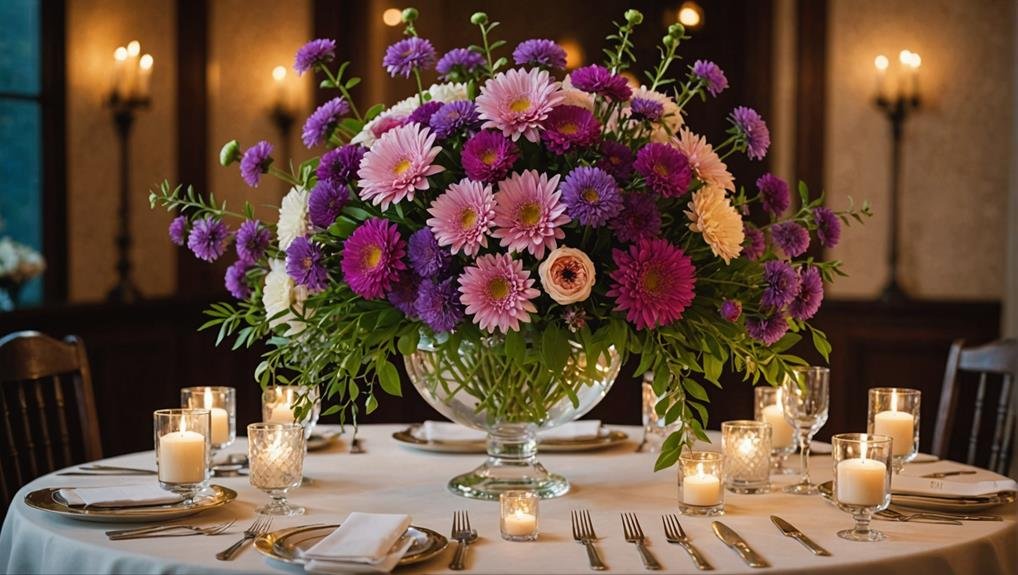
Incorporating their star-like shape and vibrant colors, these flowers are frequently featured in bridal bouquets, centerpieces, and various floral arrangements at weddings. Asters add a whimsical and romantic touch to wedding decor, symbolizing love, patience, and elegance—qualities that align perfectly with the sentiments of a wedding day. Their versatile nature allows them to enhance various wedding themes, from rustic countryside celebrations to classic, timeless ceremonies.
Asters are often paired with other blooms such as roses, sunflowers, and daisies, creating stunning arrangements that captivate the eye. Their compatibility with a wide range of flowers enables florists to design unique and personalized floral displays.
For bridal bouquets, asters provide a delicate backdrop that highlights the primary flowers while adding texture and depth. In centerpieces, they contribute to the overall charm and beauty of the event, making sure that each table setting is both inviting and aesthetically pleasing.
Their use extends beyond just bouquets and centerpieces; asters can also be incorporated into wedding arches, aisle decorations, and even boutonnieres. By including asters in your wedding, you guarantee a touch of elegance and whimsy that enhances the overall atmosphere of your special day.
Alternative Flower Types
While asters offer a whimsical and romantic touch to wedding decor, exploring alternative flower types can provide additional options for creating unique and personalized floral arrangements. Diversifying your floral choices not only enhances the visual appeal but also allows for more creative DIY flower projects.
Here are five alternative flower types that can complement or substitute asters in your wedding arrangements:
- Daisies: Known for their simplicity and charm, daisies pair well with asters to create a rustic and cheerful bouquet.
- Sunflowers: Their vibrant yellow flower heads add a bold and joyful element, perfect for a summer wedding.
- Lavender: With its soothing purple hues and aromatic scent, lavender brings a touch of elegance and tranquility.
- Baby's Breath: Often used as a filler flower, baby's breath adds a delicate and ethereal quality to any arrangement.
- Hydrangeas: Available in a range of colors, hydrangeas offer lush, voluminous blooms that can serve as stunning focal points.
Each of these flower types brings its own unique qualities to a wedding arrangement. By incorporating diverse flowers, you can craft a distinctive and memorable floral design that reflects your personal style and wedding theme.
